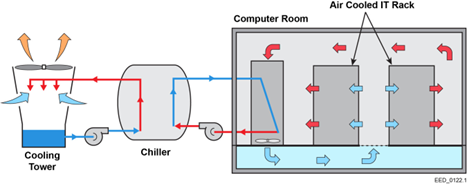*The opinions expressed in this article are the author’s own and do not reflect the official views of ICMR.

Submitted By Kalel Elyas
Artificial intelligence (AI) has had a massive rise in usage and popularity as large language models (LLM) get bigger and better. These advancements in technology have no doubt brought lots of benefits to the world yet there is one issue looming over everyone’s heads. That is “What if it goes rogue and turns into Skynet”. Well I personally don’t believe that will happen anytime soon but something that is already happening is the environmental issues that AI has and will bring to the world.
According to an MIT paper, by 2026 data centres alone would be expected to consume 1,050 terawatts annually [1]. This would place data centres at 5th place on the global list of electricity consumption or in other words more electricity consumed than the entirety of Japan in 2023. While these data centres aren’t always used for AI there is no doubt that it has had some effect on it. Would the amount of energy used be equivalent to the benefits AI can bring?
The thirst for knowledge: water usage in AI

Average cooling process in data centres
Source: US Department of Energy
From generating images to simulating particles, AI seems to be able to do it all yet everything comes at a cost. In this case freshwater, which is being used to cool these large data centres. How thirsty do these machines get you may ask. Well, AI is estimated to consume around 500ml for each 20 to 50 queries it gets. It may not seem like a large amount but we’d have to put into consideration the millions or even billions of people using AI every day over and over again. AI is already predicted to consume between 4.2 billion and 6.6 billion cubic meters of water annually by 2027 [2]. This amount of water usage is able to permanently alter many water supplies.
It doesn’t stop there, thousands of liters of water is required to fabricate a single semiconductor wafer. Add on the fact that AI requires millions of these and the amount adds up. All of this before it was even up and running. Moreover, the energy that AI uses, which as mentioned before is as much as a country requires water too. Large sources of energy like power plants and coal require large amounts of water for steam generation and cooling. In every facet of an AI’s lifespan water is used from manufacturing, powering and cooling. The unquenchable thirst for knowledge may bring us our demise.
Even worse than Skynet: AI’s carbon footprint
![]()
Source: TechInsights
It drinks and now it breathes? Not exactly breathing since it doesn’t actually take in oxygen but it does release lots of C02. This is largely due to the amount of carbon emissions during the wafer fabrication process. According to TechInsights, 172 million metric tons of carbon was released from wafer fabrication alone in the year 2024. This figure is expected to increase to 277 million metric tons by 2030 [3]. Wafer fabrication is just one part of the many processes involved in creating a semiconductor. With how AI is expected to grow more and more this means that carbon emissions from it too will continue rising.
Just like water consumption, AI has a secondary factor to carbon emissions and just like water consumption it is because of AI’s high energy usage. Energy sources like fossil fuels release the most carbon and the ever increasing demand for AI will increase fossil fuel usage. Of course this isn’t any good news as climate change is already as bad as it can get so adding upon that wouldn’t be ideal. The planet burning up would really be much much worse than Skynet.
Do we need a John Connor?: The future of sustainability in AI
As it stands AI is obviously affecting our environment and if Skynet is really a worry then killing it would be the best solution, right? I digress as there are already methods to have the best of both worlds. For example, a perfect solution is to do less for more which is being done by China’s AI, Deepseek. It achieved this by only focusing the most relevant information and ignoring redundant data [4]. Even with all the controversy surrounding Deepseek, it was able to show that quality over quantity is best for a sustainable future.
Another intuitive solution is by using AI to create more efficient methods of manufacturing semiconductors [5]. AI is known for its heavy usage of semiconductors. With how much carbon the semiconductor industry releases it seems that AI is pushing that even further. Using AI to solve this problem may seem ironic yet it is able to reduce material usage, energy consumption and of course water consumption. If LLMs like DeepSeek aren’t able to be replicated this may just be the next best thing. We may not need a John Connor with how effective these methods are becoming.
As a fellow human
AI could be the biggest turning point in humanity with its endless applications and advantages yet we still need to heavily focus on the environment. No matter how good AI could get it wouldn’t matter if the Earth isn’t around for it. Therefore we need to further implement these preexisting initiatives and come up with much better ones. There is no chopper to run to after this so we only have one shot at this.
All in all, Skynet may not be real but climate change really is and we need to act fast before it’s too late. This floating green ball is such a rare occurrence in the vastness of space so we shouldn’t take it for granted. Maybe the cost for endless knowledge is much greater than it seems.
References
- https://news.mit.edu/2025/explained-generative-ai-environmental-impact-0117
- https://www.solveo.co/post/ais-hidden-thirst-or-how-much-water-does-artificial-intelligence-really-drink
- https://www.techinsights.com/blog/global-semiconductor-carbon-emissions-forecast-2025-2030?utm_source=direct&utm_medium=website
- https://dobetter.esade.edu/en/AI-sustainable
- https://www.itnews.asia/news/ai-can-transform-semiconductor-manufacturing-boost-roi-618625
- https://www.energy.gov/femp/cooling-water-efficiency-opportunities-federal-data-centers
- Global Semiconductor Carbon Emissions Forecast, 2025-2030


